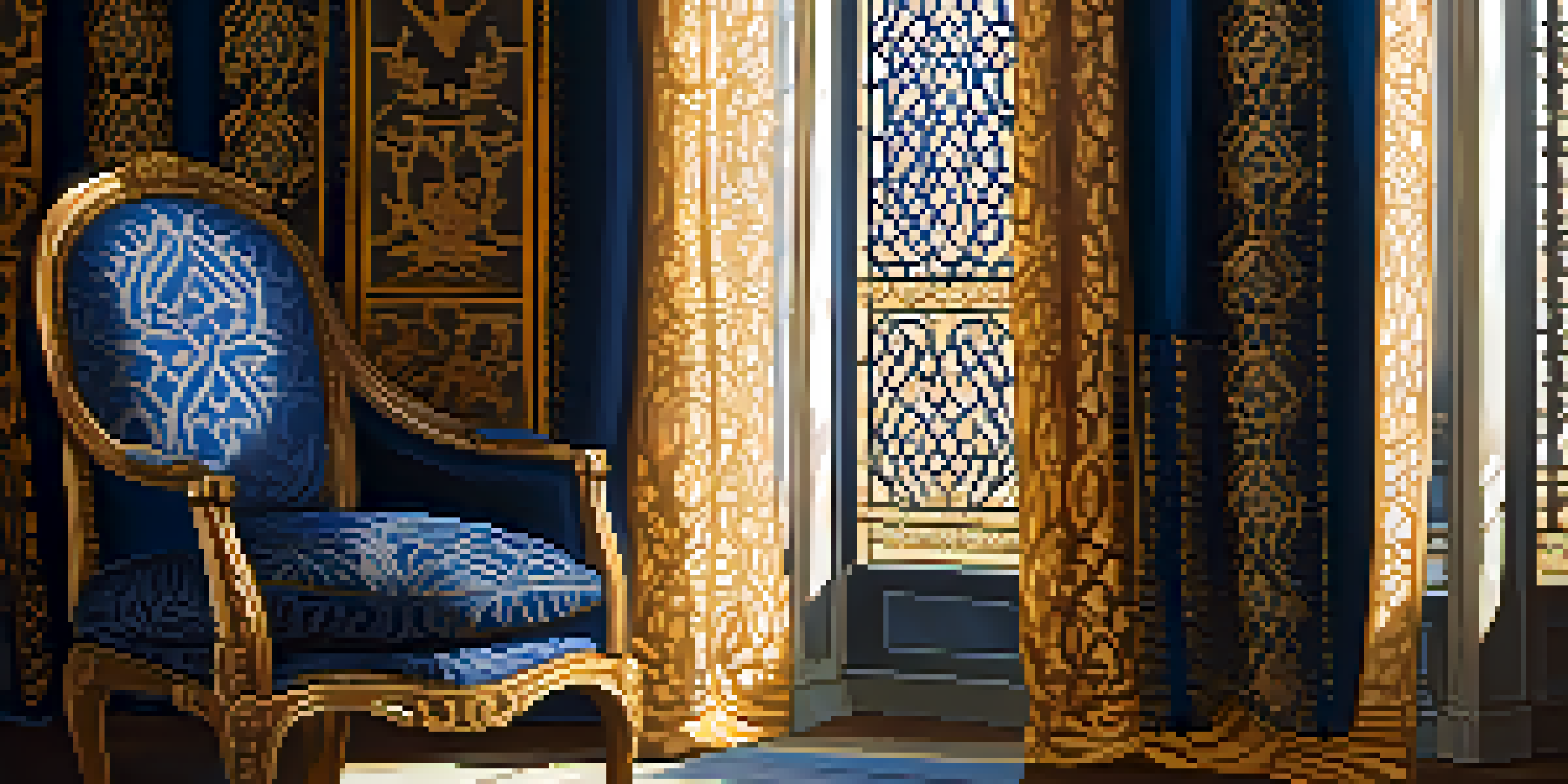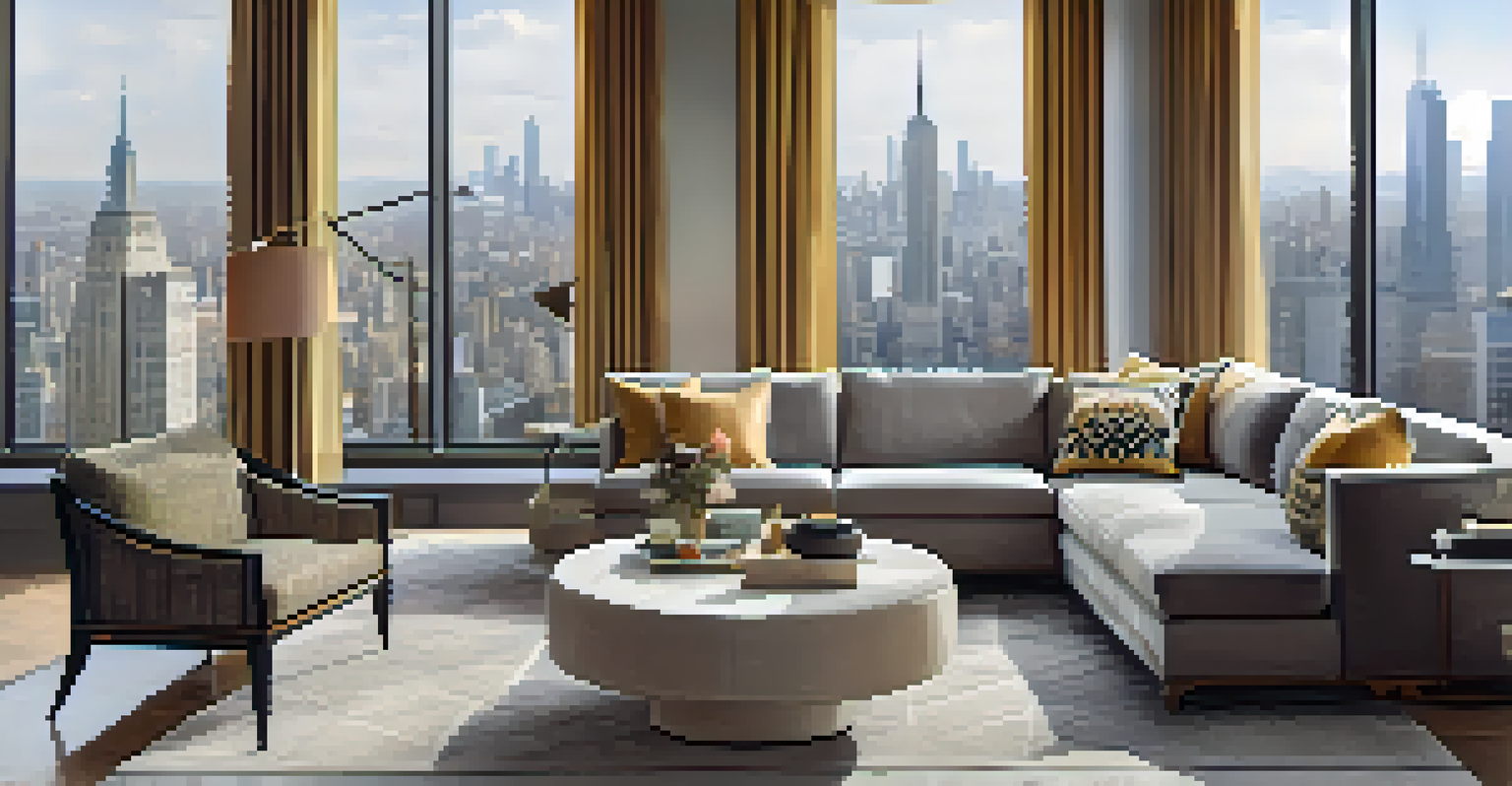Architectural Patterns: Their Influence on Textile Designs

Understanding Architectural Patterns and Their Significance
Architectural patterns are recurring structures or designs that can be found in buildings and spaces. These patterns often reflect the culture and functionality of a space, making them significant in design. They can range from the intricate details of a Gothic cathedral to the sleek lines of modernist architecture.
Architecture is the learned game, correct and magnificent, of forms assembled in the light.
When applied to textiles, these architectural elements can inspire new fabric designs that echo the beauty of built environments. Imagine a fabric that mimics the geometric shapes of a contemporary skyscraper or the ornate details of a classic structure. This cross-pollination between architecture and textiles opens up a world of creative possibilities.
Moreover, understanding these patterns allows designers to create textiles that not only look appealing but also resonate with the emotions and stories tied to architectural spaces. This connection can enhance the overall aesthetic of a space, making it feel more cohesive and intentional.
Historical Context: Architecture's Role in Textile Design
Throughout history, architecture has influenced various art forms, including textiles. For instance, during the Renaissance, textile patterns often mirrored the grand designs of cathedrals and palaces. This interplay resulted in fabrics that conveyed a sense of opulence and grandeur, much like the architecture of the time.

As we moved into the 20th century, the Bauhaus movement emerged, emphasizing the unity of design across multiple disciplines. Textile designers began to adopt architectural principles, focusing on functionality and simplicity. This approach paved the way for modern textile designs that still reflect architectural influences today.
Architecture Inspires Textile Design
Architectural patterns influence textile designs, creating a rich tapestry of creativity that enhances both aesthetics and emotional connections.
Incorporating historical architectural elements into textile design not only pays homage to the past but also enriches the narrative behind the fabric. Designers can draw inspiration from various eras, creating textiles that tell a story and evoke a sense of place.
Geometric Patterns: The Intersection of Math and Design
Geometric shapes are a prominent feature in both architecture and textiles. Structures like bridges and buildings often utilize geometry to achieve strength and beauty. Similarly, textiles incorporate geometric patterns to create visually striking designs that can range from minimalist to elaborate.
Design is not just what it looks like and feels like. Design is how it works.
Consider how a triangular pattern in a fabric can evoke the feeling of a famous pyramid or how circular motifs might remind one of domed ceilings. This connection not only enhances the visual appeal but also creates a deeper resonance with the viewer, drawing them into the design's narrative.
Furthermore, the use of geometric patterns can bring a sense of harmony and balance to textile designs. Just as architects use geometry to create pleasing proportions in their work, textile designers can achieve a similar effect, making their fabrics not just stylish but also inherently pleasing.
Organic Forms: Nature's Influence on Design Choices
Organic forms, inspired by nature, are another significant influence on both architecture and textiles. Structures that mimic natural shapes can be seen in modern architecture, where buildings often blend seamlessly into their surroundings. This trend has also seeped into textile design, leading to fabrics that feature flowing, organic patterns.
For instance, a textile design that emulates the curves of a leaf or the waves of the ocean can evoke a sense of tranquility and connection to nature. These designs not only create visual interest but also promote a sustainable ethos, reminding us of the beauty found in the environment around us.
Cultural Stories in Fabric
Textiles serve as a canvas for cultural narratives, echoing the unique architectural styles of different cultures through their patterns and designs.
By incorporating organic forms, textile designers can create pieces that feel alive and dynamic, much like the architectural marvels that inspire them. This connection can foster a sense of mindfulness, encouraging wearers and users to appreciate the beauty of both nature and design.
Cultural Reflections: Textiles as Architectural Narratives
Textiles often serve as a canvas for cultural expression, much like architecture. Different cultures have their own unique architectural styles, which can be reflected in textile designs. For example, Moroccan tiles might inspire vibrant fabric patterns that echo the intricate details of their buildings.
This cultural interplay allows textile designers to tell stories through their work, bridging the gap between different artistic disciplines. A fabric inspired by Japanese architecture might utilize subtle colors and patterns that reflect the serene beauty of traditional Japanese homes.
By understanding the architectural context of a culture, designers can create textiles that not only look beautiful but also carry deeper meanings. This narrative aspect adds value to the fabric, making it more than just a material but a piece of art with a story.
Sustainable Practices: Architectural Influence on Eco-Friendly Textiles
Sustainability is a growing concern in both architecture and textile design. Architects are increasingly focusing on eco-friendly materials and designs that minimize their environmental impact. Similarly, textile designers are seeking ways to create fabrics that are both sustainable and inspired by architectural principles.
For instance, using recycled materials or natural dyes can result in textiles that not only look good but also contribute to a healthier planet. By drawing inspiration from the principles of sustainable architecture, textile designers can innovate in ways that respect the environment.
Sustainability in Design Practices
The push for eco-friendly materials in architecture is reflected in textile design, promoting sustainable practices that benefit the environment.
This synergy between architecture and textiles fosters a greater awareness of the importance of sustainability. As both fields evolve, they can inspire one another to create designs that are not only aesthetically pleasing but also environmentally responsible.
The Future of Textile Design: Architectural Inspirations Ahead
Looking ahead, the relationship between architecture and textile design is poised for exciting developments. As technology advances, we can expect to see even more innovative designs that blend these two disciplines seamlessly. For example, 3D printing and smart textiles could lead to fabrics that adapt and change based on their environment, much like dynamic architectural structures.
Moreover, as global design trends continue to merge, we may see more cross-cultural inspirations that enrich both fields. The blending of architectural styles and textile patterns can lead to unique creations that celebrate diversity and innovation.

Ultimately, the future of textile design will likely be defined by its ability to adapt and evolve, taking cues from the architectural landscape around us. This ongoing dialogue between architecture and textiles promises to yield designs that are not only beautiful but also meaningful and functional.